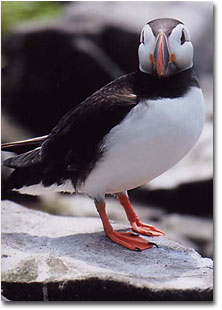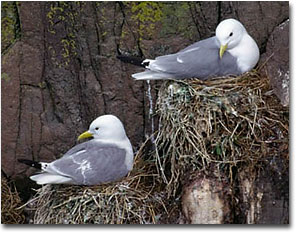|
|
 Photo Itinerary... Farne Islands, UK
Text and Photography Copyright Peter Madeley Each year at the June half term school holiday, I try to get across to the Farne Islands on the North East coast of the UK in the beautiful county of Northumberland. It is a 'mecca' for bird photographers and watchers alike, as the wide range of seabirds are so approachable. The islands are populated from early May until late August, although the best months are undoubtedly June and July - if only for the better chance of good weather. There are a variety of routes to Newcastle Upon Tyne. Proceed directly along the A1 and from there, it is a short drive of around ¾ hour to the resort of Seahouses, where excursions may be booked with a number of operators. Boat Booking The most famous of the boatmen is Billy Shields who has a fleet of 'Glad Tidings' boats and offers a special 'All Day' excursion which departs at 10am and visits Staple Island in the morning and Inner Farne in the afternoon arriving back at around 4pm. The amount of time on each island is largely weather dependant. In 2002 the cost was £18. Telephone +44 (0)1665 720 308 or go to www.farne-islands.com/boat-trips/index.htm#bird There is a landing charge of £4.40 (Peak Season) paid to the National Trust Warden for the upkeep of the islands. I would recommend that you either phone ahead or make a booking earlier in the day to ensure your place, as this tour is very popular. There are other operators, but not all include landing on the island. Waterproof clothing is needed to protect you from the spray. Landing is at the captain's discretion for safety reasons. Billy has 25 years worth of experience and was given an MBE for his services, so he really does know when it is safe to depart or make a landing.
The boat trips begin with the obligatory Seals and lighthouse stop. If you 'wail' at the seals, they will hear you and reply with a similar song. Shooting at 1/500 and a 300mm lens, I was unable to make a sharp image due to vibration of the engine, although I have been on outings where the engine was cut and then with an Image Stabilizer lens, I was able to capture some good images of the birds on the water. 1 in every 10,000 guillemots has a white ring around the eye and it is worth looking out for these 'bridled' individuals to be the focal point of a group photograph. Time on Staple Island is limited to 2 hours or so. The temptation is to follow the crowd across the island, but I found the best area for puffin portraits is right at the top of the stone jetty looking out towards the sea. This can give a deep blue background rather than an out of focus colony or sky which can occur in other places. I used a 400mm zoom and a beanbag, as intense half term visitor traffic during the day had pushed the birds slightly further away than on previous visits. A 75-300mm zoom is an ideal starting point for puffin groups and full length portraits. A short extension tube would be wise to have in your pocket as you can often find yourself very close to these attractive little clowns as they soon gain and ignore your presence. I shot on Sensia ISO100 and pushed the film to ISO200 to get a little more depth of field by shooting at f8 where possible to keep the beak in sharp focus, especially when the face was not parallel to the film plane. A bright but overcast day helps to keep detail in the feathers and allows centre weighted metering directly from the bird with just a little exposure compensation. In bright sun, I looked for areas of grass to meter from rather than the very white guano encrusted rocks. The steps lead to a wooden boardwalk from which where you can photograph puffins amongst the thrift although, the narrow boardwalk means it is not easy to get a low viewpoint unless you use an angle finder or make a nuisance of yourself by lying down, as I did in the last occasion. Eventually the path leads to a large open cliff top. From here be careful not to step on the Shag nests which cover this area. I have photographed them with a 28mm lens and find that if you approach low, the birds are more accepting than from above. On the cliffs you can make groups of puffin/cormorant compositions and there are several Kittiwake nests which are within 300mm range. Inner Farne It is easy to make a landing, as it is sheltered in St. Cuthbert's Cove. The first thing that strikes you is the intense sound coming from the arctic tern colony. The second thing may be a tern itself, as the birds dive bomb visitors to defend their nests. A bobble hat perched high on your head is the best defence and I have seen them draw blood from an uncovered scalp. You walk along a low roped boardwalk and the birds nest a few centimetres on the other side, so extreme close ups are relatively easy. Look closely as you may also find female eiders. In one case, I was able to get within 20cm with a macro lens to shoot an eye close up and without causing distress to the bird. It is possible to get shots of the Terns coming into the nest with a 100mm lens but be wary they don't attack and scratch the front element of your lens. I used -2stop fill flash to produce a catch light to bring the image to life and separate the eye from the head feathers.
I used the Staple Island visit to concentrate on puffins, shag and kittiwake. This gave plenty of time for Tern photography on Inner Farne. You many also be fortunate, if the boatman takes you into 'The Pinnacles', to see the guillemots nesting in the rock. They may even start porpoising alongside the boat which gives opportunities for some blurred slow shutter experiments. Each time I visit this colony, I find something new to photograph and add to my Farnes collection. It is rather an expensive day out, but once you are under its spell the magic draws you back year on year. What Else to Shoot At low tide, a couple of happy hours can be spend around the rock pools just to the north of Seahouses harbour. There are many tidal pools of brightly coloured seaweed and the possibilities for barnacle or seaweed abstracts are seemingly endless. There is often a small group of eider ducks which swim around the pools often organised in crèches and will come close to a patient and still photographer. The males are a beautiful cream and black and coo loudly to the females tossing their heads back as they do. The heads are very dark and, even on a bright day, the eye can be difficult to see. A blip of fill flash can provide the necessary catch light to lift the image. Just up the coastline (3 miles) is the spectacular Bamburgh castle which looks great from the beach in early morning or in silhouette at sunset from the Seahouses side on the highest dune. Bamburgh is also good for accommodation and is home to the Grace Darling Museum which tells of the famous rescue of 'The Forfarshire' and how the lighthouse keeper and his daughter rowed through a storm to rescue the survivors. A short drive (15 miles) takes you to Holy Island, also known as Lindesfarne, now reopened after the foot and mouth tragedy of 2001. There is a sand dune based nature reserve on the island maintained by English Nature. In summer, Dark Green Fritillary Butterflies and orchids can be photographed here. Check the tide timetables for safe crossing periods over the causeway connecting the island to the mainland. Recently there had been an algal bloom on the mudflats which has been thought to have poisoned many shellfish. Along the high tide line I found tens of thousands of juvenile crab's carapaces which had been bleached by the sun. Not a nice state of affairs, but I felt it needed recording. The North East of England has a great deal to offer the wildlife photographer. It has more than just the Farne Islands though this is certain the Jewel of the area. Pay it a visit and you will not be disappointed. PM - NPN 438 Comments on this article? Send them to the editor. |
|
|
 Alternatively, you may like to do a workshop on the islands which is organised by Chris Edwards of Global Photo Site. Further details are available on
Alternatively, you may like to do a workshop on the islands which is organised by Chris Edwards of Global Photo Site. Further details are available on  Midway along the path you come to the main tern colony, bullied by gulls, the main predator on the island. Up near the lighthouse there are groups of puffin, shag and kittiwake. On the Churn side of the island, you will find a myriad of muddy puffin burrows and may be fortunate to find a little monochrome face poking out which makes for an interesting portrait.
Midway along the path you come to the main tern colony, bullied by gulls, the main predator on the island. Up near the lighthouse there are groups of puffin, shag and kittiwake. On the Churn side of the island, you will find a myriad of muddy puffin burrows and may be fortunate to find a little monochrome face poking out which makes for an interesting portrait.